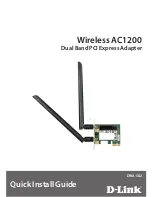
Advanced information
Intel High Priority Queue
If your network infrastructure devices don't support IEEE_802.1p, or if you're not sure,
you can still define filters and send packets as high priority by assigning them to the
High Priority Queue (HPQ). To do this, you use Priority Packet when you create or
assign a filter. This method doesn't provide the precise priority levels of 802.1p tagging,
but it does assign high or low priority to traffic and send packet with high priority first.
Therefore, if there are multiple applications on a system sending packets, the packets
from the application with a filter are sent out first. HPQ doesn't change network routing,
nor does it add any information to the packets.
Using Wake on LAN
The Wake on LAN (WOL) feature operates according to a published specification. In
simple terms, the specification enables designers to build network adapters that are
capable of “listening” to network activity even when the computer is turned off. WOL
adapters have a special low-power standby mode that is active when the rest of the
computer is without power. The adapter will respond to a special wake-up packet sent by
another computer or network device. Typically this wake-up packet causes the adapter to
signal the computer to power up and run a predefined program.
Virtual LAN
A Virtual LAN (VLAN) is a logical grouping of network devices put together as a LAN
regardless of their physical grouping or collision domains.
If you use the VLAN, the following is required:
Windows NT 4.0 with Service Pack 4.0 (or later) or Service Pack 3.0 and the NDIS
driver hotfix from Microsoft.
When a VLAN is used, a user see and access only specified network segments. This
improves network performance and improves network security. VLANs offer the ability
to group users and stations together into logical work-groups. This can simplify network
administration when clients are connecting to servers that are geographically dispersed
across a building, a campus, or an enterprise network.
Typically, VLANs consist of co-workers within the same department but in different
locations, groups of users running the same network protocol, or a cross-functional team
working on a joint project. Joining workers with VLANs forms logical working groups.
Normally, VLANs are configured at the switch and any computer can be a member of
one VLAN per installed network adapter. The PRO/100 adapter supersedes this by
communicating directly with a switch, so that up to 64 VLANs can be on a single
adapter. To set up VLAN membership, your adapter must be attached to a switch that
has VLAN capability.
How to join a VLAN from Windows NT 4.0
To join a VLAN, do as follows:
1
Create a VLAN on the switch. Use the parameters you assign there to join the
VLAN from the server. For more information for your switch, see the
documentation.
2
Double-click Network in Control Panel.
3
On the Adapters tab, select the adapter you want to be on a VLAN.
12
Содержание 10/100 Ethernet Mini-PCI Adapter
Страница 1: ...IBM 10 100 EtherJet Mini PCI Adapter with 56K Modem User s Guide ...
Страница 4: ......
Страница 6: ......
Страница 10: ...x ...
















































